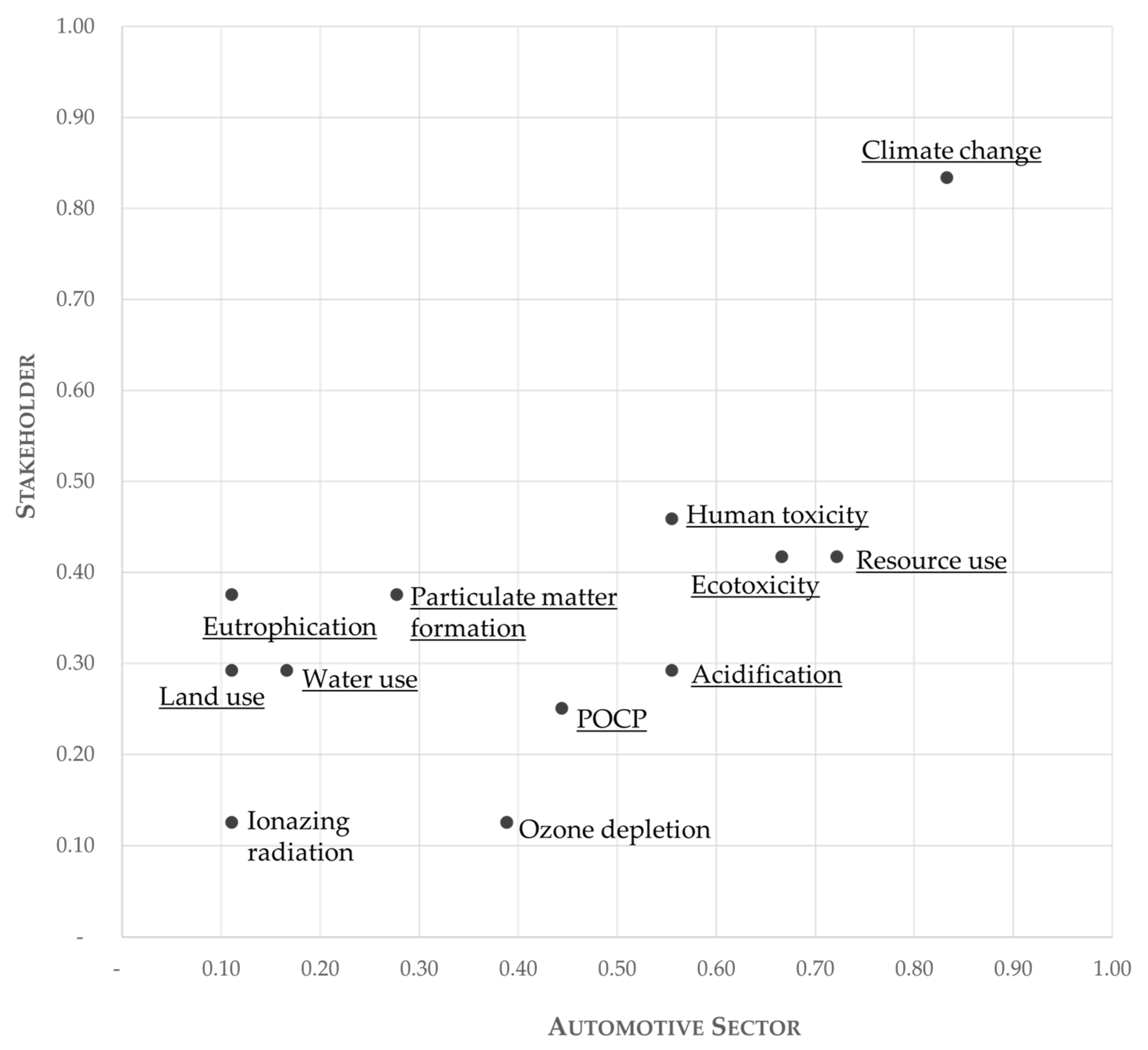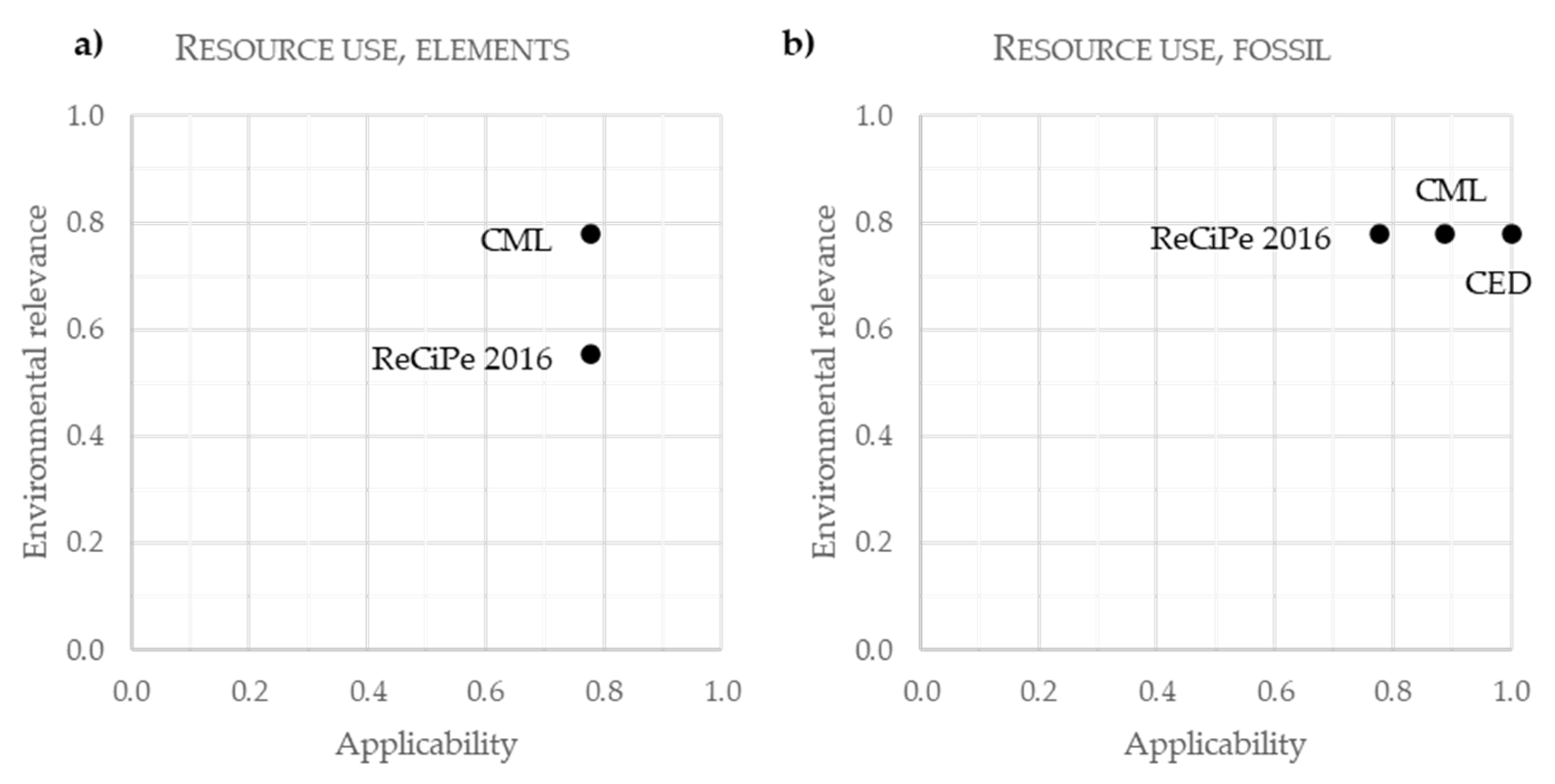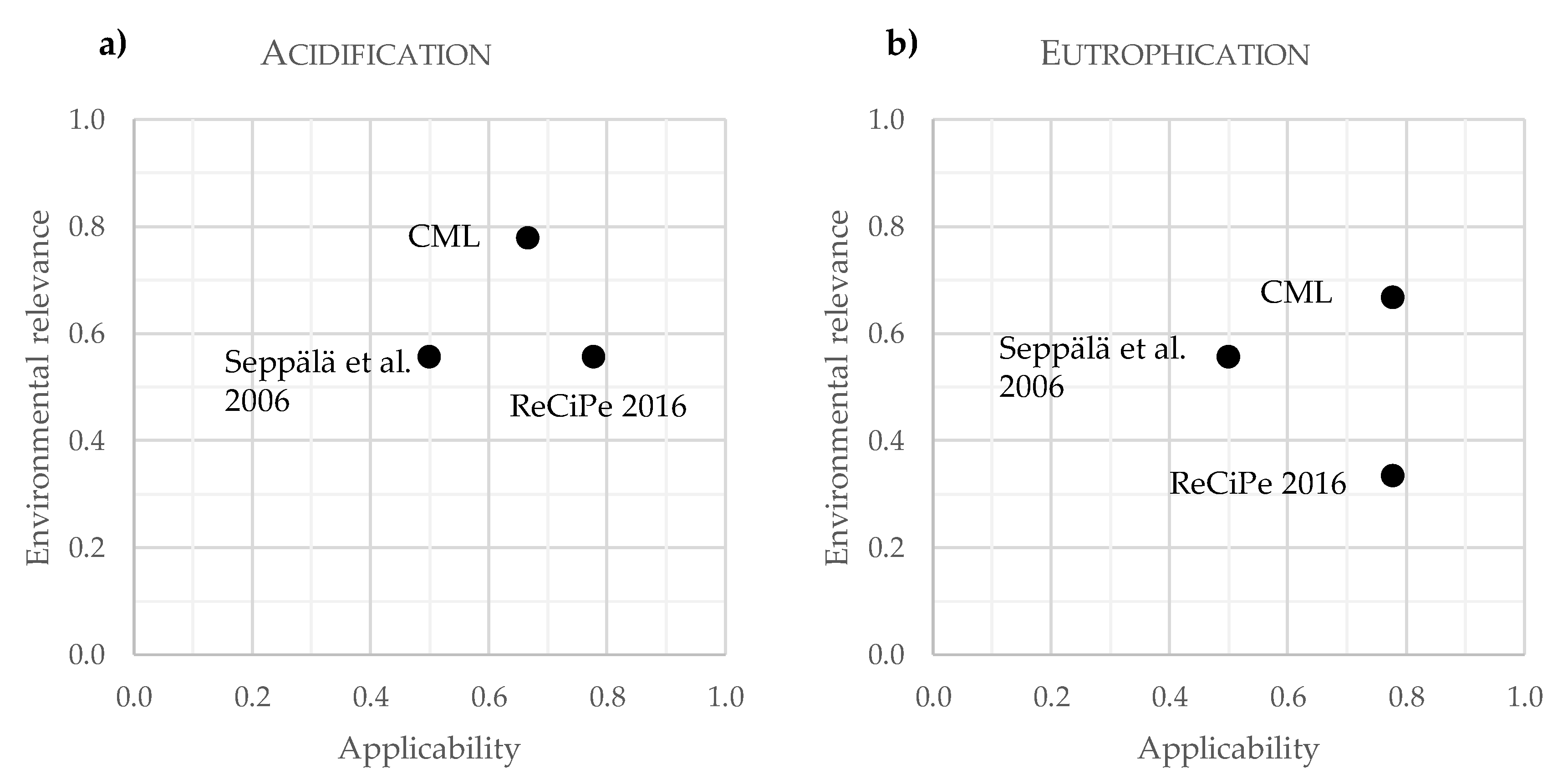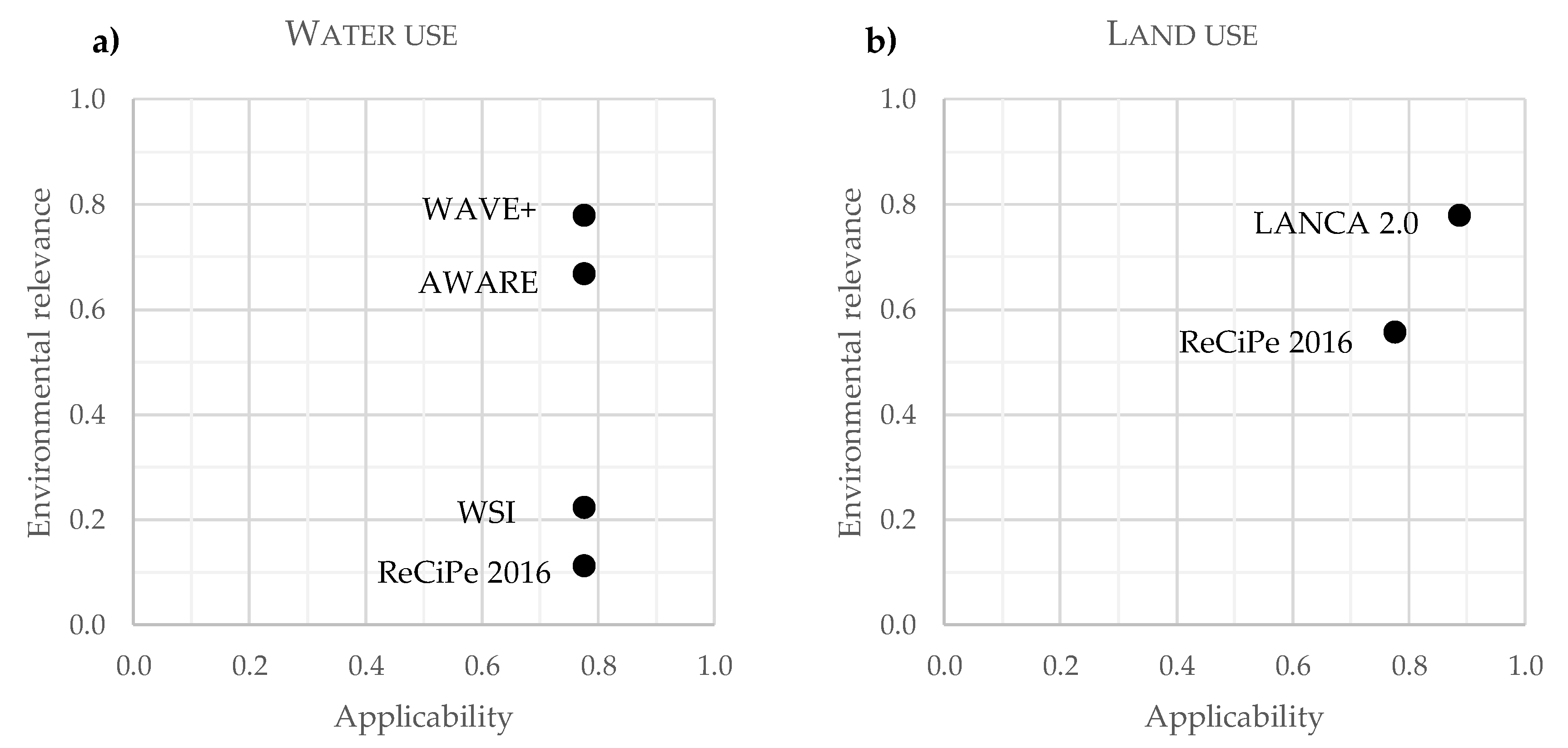Relevance of Impact Categories and Applicability of Life Cycle Impact Assessment Methods from an Automotive Industry Perspective
Abstract
:1. Introduction
2. Materials and Methods
2.1. Identification of Relevant Impact Categories
- Total result over 1.0: very high relevance
- Total result over 0.75: high relevance
- Total result equal to or over 0.5: medium relevance
- Total result below 0.5: low relevance.
2.2. Identification of Relevant LCIA Methods
3. Results
3.1. Relevant Impact Categories
- Very high: climate change, human toxicity, ecotoxicity and resource use;
- High: acidification;
- Medium: POCP, ozone depletion, particulate matter formation;
- Low: eutrophication, ionizing radiation, water use, land use.
3.2. Relevant LCIA Methods
3.2.1. Considered LCIA Methods
3.2.2. Results of the Evaluation of LCIA Methods
- Resource use, elements
- Resource use, fossil
- Human toxicity
- Ecotoxicity
- Acidification
- Eutrophication
- Photochemical ozone creation potential
- Particulate matter formation
- Water use
- Land use
4. Discussion and Conclusions
Author Contributions
Funding
Institutional Review Board Statement
Informed Consent Statement
Data Availability Statement
Conflicts of Interest
References
- European Commission. PEFCR Guidance Document—Guidance for the Development of Product Environmental Footprint Category Rules (PEFCRs), Version 6.3; European Commission: Brussels, Belgium, 2017. [Google Scholar]
- Schmitz, S.; Paulini, I. Bewerting in Ökobilanzen. Methode des Umweltbundesamter zur Normierung von Wirkungsindikatoren, Ordnung (Rangbildung) von Wirkungskategorien und zur Auswertung nach ISO 14042 und 14043; Umweltbundesamt: Berlin, Germany, 1999. [Google Scholar]
- European Commission—Joint Research Centre—Institutefor Environment and Sustainability. International Reference Life Cycle Data System (ILCD) Handbook—Recommendations for Life Cycle Impact Assessment in the European Context; Publications Office of the European Union: Luxembourg, 2011. [Google Scholar]
- UNEP. Global Guidance for Life Cycle Impact Assessment Indicators Volume 2; UNEP: Nairobi, Kenya, 2019. [Google Scholar]
- UNEP/SETAC Life Cycle Initiative. Global Guidance for Life Cycle Impact Assessment Indicators Volume 1; UNEP: Nairobi, Kenya, 2016. [Google Scholar]
- Bach, V.; Finkbeiner, M. Approach to qualify decision support maturity of new versus established impact assessment methods—demonstrated for the categories acidification and eutrophication. Int. J. Life Cycle Assess. 2017, 22, 387–397. [Google Scholar] [CrossRef] [Green Version]
- Lehmann, A.; Bach, V.; Finkbeiner, M. Product environmental footprint in policy and market decisions: Applicability and impact assessment. Integr. Environ. Assess. Manag. 2015, 11, 417–424. [Google Scholar] [CrossRef] [PubMed] [Green Version]
- Schweimer, G.W.; Schluckert, M. Sachbilanz eines Golf. Ganzheitliche Betrachtungen im Automobilbau. In VDI-Berichte 1307; Verein Deutscher Ingenieure (VDI): Wolfsburg, Germany, 1996. [Google Scholar]
- Leiden University. CML-IA Characterisation Factors. 2012. Available online: https://www.universiteitleiden.nl/en/research/research-output/science/cml-ia-characterisation-factors (accessed on 12 December 2020).
- Huijbregts, M.A.J.; Steinmann, Z.J.N.; Elshout, P.M.F.; Stam, G.; Verones, F.; Vieira, M.; Zijp, M.; Hollander, A.; van Zelm, R. ReCiPe2016: A harmonised life cycle impact assessment method at midpoint and endpoint level. Int. J. Life Cycle Assess. 2017, 22, 138–147. [Google Scholar] [CrossRef]
- Lisowski, S.; Berger, M.; Caspers, J.; Mayr-Rauch, K.; Bäuml, G.; Finkbeiner, M. Criteria-Based Approach to Select Relevant Environmental SDG Indicators for the Automobile Industry. Sustainability 2020, 12, 8811. [Google Scholar] [CrossRef]
- Lisowski, S.; Bunsen, J.; Berger, M.; Finkbeiner, M. Implementation of the Sustainable Development Goals in the private sector—Quantifying and comparing footprints of industries. J. Clean. Prod. 2021; submitted. [Google Scholar]
- Daimler AG Merzedes-Benz Modelle Mit 360-Umweltcheck. Available online: https://www.daimler.com/nachhaltigkeit/umweltzertifikate/ (accessed on 20 February 2021).
- Ford Motor Company Product Sustainability Index. Available online: https://corporate.ford.com/microsites/integrated-sustainability-and-financial-report-2021/files/ir21-ford-psi.pdf (accessed on 20 February 2021).
- American Honda Motor Co. The Honda North American Environmental Report (NAER). Available online: https://csr.honda.com/wp-content/uploads/2020/11/NAER_2019.pdf (accessed on 21 February 2021).
- Renault Group Renault Kadjar—2015—Life Cycle Assessment Results—Renault LCA Methodology. Available online: https://www.renaultgroup.com/wp-content/uploads/2017/02/final_en_rapport-kadjar_nonconf.pdf (accessed on 21 February 2021).
- BMW AG Environmental Report BMW 320dA. Available online: https://www.bmwgroup.com/content/dam/grpw/websites/bmwgroup_com/responsibility/downloads/en/2020/Environmental-report_BMW-320d.pdf (accessed on 1 March 2021).
- Romare, M.; Hanarp, P. Comparison of Diesel and Gas Distribution Trucks—A Life Cycle Assessment Case Study; Report No 2017:20, f3; The Swedish Knowledge Centre for Renewable Transportation Fuels: Göteborg, Sweden, 2017. [Google Scholar]
- European Union. Regulation (EU) 2019/631 of the European Parliament and of the Council of 17 April 2019 Setting CO2 Emission Performance Standards for New Passenger Cars and for New Light Commercial Vehicles, and Repealing Regulations (EC) No 443/2009 and (EU) No 510/201 2019; European Union: Maastricht, The Netherlands, 2020. [Google Scholar]
- European Union. Directive 2011/92/EU of the European Parliament and of the Council of 13 December 2011 on the Assessment of the Effects of Certain Public and Private Projects on the Environment; European Union: Maastricht, The Netherlands, 2011. [Google Scholar]
- European Commission. A European Green Deal. Available online: https://ec.europa.eu/info/strategy/priorities-2019-2024/european-green-deal_en#documents (accessed on 1 December 2020).
- Wendling, Z.A.; Emerson, J.W.; de Sherbinin, A.; Esty, D.C. Environmental Performance Index. 2020 Technical Appendix; Yale Center for Environmental Law & Policy: New Haven, CT, USA, 2020. [Google Scholar]
- World Economic Forum. The Global Risks Report 2020; World Economic Forum: Cologny, Switzerland, 2020. [Google Scholar]
- Rockström, J.; Steffen, W.; Noone, K.; Persson, Å.; Chapin, F.S.; Lambin, E.; Lenton, T.M.; Scheffer, M.; Folke, C.; Schellnhuber, H.J.; et al. Planetary Boundaries: Exploring the Safe Operating Space for Humanity. Ecol. Soc. 2009, 14, 2. [Google Scholar] [CrossRef]
- Steffen, W.; Richardson, K.; Rockström, J.; Cornell, S.E.; Fetzer, I.; Bennett, E.M.; Biggs, R.; Carpenter, S.R.; De Vries, W.; De Wit, C.A.; et al. Planetary boundaries: Guiding human development on a changing planet. Science 2015, 347, 1259855. [Google Scholar] [CrossRef] [Green Version]
- S&P Dow Jones Indices Dow Jones Sustainability Index. Available online: https://www.spglobal.com/spdji/en/indices/esg/dow-jones-sustainability-world-index/#data (accessed on 10 December 2020).
- GRI. Consolidated Set of GRI Sustainability Reporting Standards 2020; GRI: Amsterdam, The Netherlands, 2020. [Google Scholar]
- Berger, M.; Sonderegger, T.; Alvarenga, R.; Bach, V.; Cimprich, A.; Dewulf, J.; Frischknecht, R.; Guinée, J.; Helbig, C.; Huppertz, T.; et al. Mineral resources in life cycle impact assessment: Part II—Recommendations on application-dependent use of existing methods and on future method development needs. Int. J. Life Cycle Assess. 2020, 25, 798–813. [Google Scholar] [CrossRef] [Green Version]
- Sphera Solutions GaBi. Available online: https://gabi.sphera.com/deutsch/index/ (accessed on 20 March 2021).
- PRé Sustainability B.V. SimaPro. Available online: https://simapro.com/ (accessed on 20 March 2021).
- Guinee, J.B. Handbook on life cycle assessment operational guide to the ISO standards. Int. J. Life Cycle Assess. 2002, 7, 311–313. [Google Scholar] [CrossRef]
- Van Oers, L. Abiotic Resource Depletion in LCA; Universiteit Leiden: Amsterdam, The Netherlands, 2002. [Google Scholar]
- Vieira, M.D.M.; Ponsioen, T.C.; Goedkoop, M.J.; Huijbregts, M.A.J. Surplus Ore Potential as a Scarcity Indicator for Resource Extraction. J. Ind. Ecol. 2017, 21, 381–390. [Google Scholar] [CrossRef]
- Jungbluth, N.; Frischknecht, R. Cumulative energy demand. In Implementation of Life Cycle Impact Assessment Methods; Hischier, R., Weidema, B., Eds.; Ecoinvent Centre: St Gallen, Switzerland, 2010; pp. 33–40. [Google Scholar]
- Frischknecht, R.; Wyss, F.; Büsser Knöpfel, S.; Lützkendorf, T.; Balouktsi, M. Cumulative energy demand in LCA: The energy harvested approach. Int. J. Life Cycle Assess. 2015, 20, 957–969. [Google Scholar] [CrossRef]
- VDI 4600. Cumulative Energy Demand (KEA). Terms, Definitions, Methods of Calculation; Beuth Verlag GmbH: Duesseldorf, Germany, 2012. [Google Scholar]
- Huijbregts, M.A.J.; Thissen, U.; Guinée, J.B.; Jager, T.; Kalf, D.; Van De Meent, D.; Ragas, A.M.J.; Wegener Sleeswijk, A.; Reijnders, L. Priority assessment of toxic substances in life cycle assessment. Part I: Calculation of toxicity potentials for 181 substances with the nested multi-media fate, exposure and effects model USES-LCA. Chemosphere 2000, 41, 541–573. [Google Scholar] [CrossRef]
- Van Zelm, R.; Huijbregts, M.A.J.; Van De Meent, D. USES-LCA 2.0-a global nested multi-media fate, exposure, and effects model. Int. J. Life Cycle Assess. 2009, 14, 282–284. [Google Scholar] [CrossRef]
- Rosenbaum, R.K.; Bachmann, T.M.; Gold, L.S.; Huijbregts, M.A.; Jolliet, O.; Juraske, R.; Koehler, A.; Larsen, H.F.; MacLeod, M.; Margni, M.; et al. USEtox—The UNEP-SETAC toxicity model: Recommended characterisation factors for human toxicity and freshwater ecotoxicity in life cycle impact assessment. Int. J. Life Cycle Assess. 2008, 13, 532–546. [Google Scholar] [CrossRef] [Green Version]
- Guinee, J.B.; Gorrée, M.; Heijungs, R.; Huppes, G.; Kleijn, R.; De Koning, A.; Van Oers, L.; Wegener Sleeswijk, A.; Suh, S.; Udo de Haes, H.A.; et al. An Operational Guide to the ISO-Standards. Part 3: Scientific Background; Kluwer Academic Publishers: Dordrecht, The Netherlands, 2002. [Google Scholar]
- Roy, P.O.; Azevedo, L.B.; Margni, M.; van Zelm, R.; Deschênes, L.; Huijbregts, M.A.J. Characterization factors for terrestrial acidification at the global scale: A systematic analysis of spatial variability and uncertainty. Sci. Total Environ. 2014, 500–501, 270–276. [Google Scholar] [CrossRef]
- Seppälä, J.; Posch, M.; Johansson, M.; Hettelingh, J.P. Country-dependent characterisation factors for acidification and terrestrial eutrophication based on accumulated exceedance as an impact category indicator. Int. J. Life Cycle Assess. 2006, 11, 403–416. [Google Scholar] [CrossRef]
- Helmes, R.J.K.; Huijbregts, M.A.J.; Henderson, A.D.; Jolliet, O. Spatially explicit fate factors of phosphorous emissions to freshwater at the global scale. Int. J. Life Cycle Assess. 2012, 17, 646–654. [Google Scholar] [CrossRef] [Green Version]
- Derwent, R.G.; Jenkin, M.E.; Saunders, S.M.; Pilling, M.J. Photochemical ozone creation potentials for organic compounds in northwest Europe calculated with a master chemical mechanism. Atmos. Environ. 1998, 32, 2429–2441. [Google Scholar] [CrossRef]
- Van Zelm, R.; Preiss, P.; van Goethem, T.; Van Dingenen, R.; Huijbregts, M. Regionalized life cycle impact assessment of air pollution on the global scale: Damage to human health and vegetation. Atmos. Environ. 2016, 134, 129–137. [Google Scholar] [CrossRef] [Green Version]
- van Zelm, R.; Huijbregts, M.A.J.; den Hollander, H.A.; van Jaarsveld, H.A.; Sauter, F.J.; Struijs, J.; van Wijnen, H.J.; van de Meent, D. European characterization factors for human health damage of PM10 and ozone in life cycle impact assessment. Atmos. Environ. 2008, 42, 441–453. [Google Scholar] [CrossRef]
- Fantke, P.; Jolliet, O.; Apte, J.S.; Hodas, N.; Evans, J.; Weschler, C.J.; Stylianou, K.S.; Jantunen, M.; McKone, T.E. Characterizing Aggregated Exposure to Primary Particulate Matter: Recommended Intake Fractions for Indoor and Outdoor Sources. Environ. Sci. Technol. 2017, 51, 9089–9100. [Google Scholar] [CrossRef] [Green Version]
- Döll, P.; Siebert, S. Global modeling of irrigation water requirements. Water Resour. Res. 2002, 38, 8-1–8-10. [Google Scholar] [CrossRef]
- Hoekstra, A.Y.; Mekonnen, M.M. The water footprint of humanity. Proc. Natl. Acad. Sci. USA 2012, 109, 3232–3237. [Google Scholar] [CrossRef] [PubMed] [Green Version]
- Boulay, A.-M.; Bare, J.; Benini, L.; Berger, M.; Lathuillière, M.J.; Manzardo, A.; Margni, M.; Motoshita, M.; Núñez, M.; Pastor, A.V.; et al. The WULCA consensus characterization model for water scarcity footprints: Assessing impacts of water consumption based on available water remaining (AWARE). Int. J. Life Cycle Assess. 2018, 23, 368–378. [Google Scholar] [CrossRef] [Green Version]
- Pfister, S.; Koehler, A.; Hellweg, S. Assessing the Environmental Impact of Freshwater Consumption in Life Cycle Assessment. Environ. Sci. Technol. 2009, 43, 4098–4104. [Google Scholar] [CrossRef] [Green Version]
- Berger, M.; Eisner, S.; Van Der Ent, R.J.; Floerke, M.; Link, A.; Poligkeit, J.; Bach, V.; Finkbeiner, M. Enhancing the water accounting and vulnerability evaluation model: WAVE+. Environ. Sci. Technol. 2018, 52, 10757–10766. [Google Scholar] [CrossRef] [Green Version]
- De Baan, L.; Alkemade, R.; Koellner, T. Land use impacts on biodiversity in LCA: A global approach. Int. J. Life Cycle Assess. 2013, 18, 1216–1230. [Google Scholar] [CrossRef]
- Bos, U.; Horn, R.; Beck, T.; Lindner, J.P.; Fischer, M. LANCA—Characterization Factors for Life Cycle Impact Assessment. Version 2.0; Fraunhofer Verlag: Stuttgart, Germany, 2016. [Google Scholar]
- Bos, U.; Maier, S.D.; Horn, R.; Leistner, P.; Finkbeiner, M. A GIS based method to calculate regionalized land use characterization factors for life cycle impact assessment using LANCA®. Int. J. Life Cycle Assess. 2020, 25, 1259–1277. [Google Scholar] [CrossRef]
- IPCC. Climate Change 2013—The Physical Science Basis: Working Group I Contribution to the Fifth Assessment Report of the Intergovernmental Panel on Climate Change; Cambridge University Press: Cambridge, UK, 2014. [Google Scholar]
- Bulle, C.; Margni, M.; Patouillard, L.; Boulay, A.M.; Bourgault, G.; De Bruille, V.; Cao, V.; Hauschild, M.; Henderson, A.; Humbert, S.; et al. IMPACT World+: A globally regionalized life cycle impact assessment method. Int. J. Life Cycle Assess. 2019, 24, 1653–1674. [Google Scholar] [CrossRef] [Green Version]
- Verones, F.; Hellweg, S.; Antón, A.; Azevedo, L.B.; Chaudhary, A.; Cosme, N.; Cucurachi, S.; Baan, L.; Dong, Y.; Fantke, P.; et al. LC-IMPACT: A regionalized life cycle damage assessment method. J. Ind. Ecol. 2020, 24, 1201–1219. [Google Scholar] [CrossRef]







| Criteria Group/Criterion | Data and Source | Relevance Evaluated Based on | Relevance |
|---|---|---|---|
| 1 Automotive sector | |||
| 1.1 Current contribution to impact categories | |||
| 1.1.a Production phase | LCA of an ICE vehicle (Volkswagen AG) | Normalized LCIA results | Internal data of Volkswagen AG |
| 1.1.b Use phase | LCA of an ICE vehicle (Volkswagen AG) | Normalized LCIA results | Internal data of Volkswagen AG |
| 1.2 Future contribution to impact categories | |||
| 1.2.a Production phase | LCA of an EV (Volkswagen AG) | Normalized LCIA results | Internal data of Volkswagen AG |
| 1.2.b Use phase | LCA of an EV (Volkswagen AG) | Normalized LCIA results | Internal data of Volkswagen AG |
| 1.3 Contribution to SDGs | Contribution of automotive industry to SDG indicators [11,12] | Contribution (%) | Very high (>30%), high (20–30%), medium (10–20%), low (<10%) |
| 1.4 Reporting frequency | LCA reports of six automotive companies | Number of companies that report the impact category | Very high (6), high (3–5), medium (1–2), low (0) |
| 2 Stakeholders | |||
| 2.1 Politics | |||
| 2.1.a Existing legislation | 8 regulations and 32 directives | Number of times an impact category is addressed and if a quantitative threshold and/or target is provided | Very high (>10), high (7–10), medium (3–7), low (<3) |
| 2.1.b Future legislation | EU Green Deal, 9 policy areas [21] | Number of times an impact category is addressed and if a quantitative threshold and/or target is provided | Very high (>4), high (2–4), medium (1–2), low (<1) |
| 2.1.c Product Environmental Footprint | Weighting factors for environmental footprint [1] | Final weighting factors for each impact category | Very high (>20), high (7–20), medium (4–7), low (<4) |
| 2.1.d Environmental Performance Index | 11 issue categories including 32 indicators [22] | Weight of issue categories and indicators | Very high (>20%), high (10–20%), medium (3–7%), low (<3%) |
| 2.2 Other stakeholders | |||
| 2.2.a World Economic Forum | The Global Risk Report 2020 [23] | Environmental issues addressed | All addressed issues are evaluated with a high relevance |
| 2.2.b Planetary boundaries | Steffen et al. [25] | The status of the impact categories with regard to planetary boundaries | High (beyond zone of uncertainty), medium (in zone of uncertainty), low (below boundary) |
| 2.2.c Dow Jones Sustainability Index | 31 indicators for environmental dimension [26] | Number of times addressed | Very high (>15), high (10–15), medium (3–7%), low (<3%) |
| 2.2.d Global Reporting Initiative | 32 indicators for environmental issues [27] | Number of times addressed | |
| Criteria Group/Criterion | Description |
|---|---|
| 1 Applicability | |
| 1.1 The method is globally valid | CFs are applicable only for a specific region (e.g., Europe) or worldwide |
| 1.2 Characterization factors are available | CFs for the application of the method are provided (e.g., online for download) |
| 1.3 Inventory data are adequate | The inventory data needed for the application of the method are available in the automotive sector |
| 1.4 The method is integrated in an LCA Software | The method is available in a software, e.g., GaBi [29] or SimaPro [30] |
| 1.5 The method is robust for communication | The method and provided results are mature enough for communication |
| 1.6 The method is understandable for the non-LCA community | The calculation procedure and results (including units) are understandable for non-LCA experts |
| 2 Environmental relevance | |
| 2.1 Relevant substances are considered 1 | All substances contributing to the impact category are considered |
| 2.2 Relevant distribution pathways are considered 2 | The fate modelling is included in the method |
| 2.3 Relevant damage areas are considered | All relevant damage areas (e.g., both terrestrial and aquatic ecosystems for eutrophication) are considered |
| Impact Category | CML | ReCiPe 2016 | ILCD/PEF/UNEP Recommendation |
|---|---|---|---|
| Resource use, elements | ADP ultimate reserves (Guinée 2002 [31] and van Oers et al. 2002) [32] | SOP (Vieira et al. 2016) [33] | Same as in CML |
| Resource use, fossil 1 | ADP-fossil (Guinée 2002 [31] and van Oers et al. 2002) [32] | FFP (Jungbluth and Frischknecht 2010) [34] | Same as in CML |
| Human toxicity | USES-LCA (Huijbregts et al. 2000) [37] | USES-LCA 2.0 (van Zelm et al. 2009) [38] | USEtox (Rosenbaum et al. 2008) [39] |
| Ecotixicity | USES-LCA (Huijbregts et al. 2000) [37] | USES-LCA 2.0 (van Zelm et al. 2009) [38] | USEtox (Rosenbaum et al. 2008) [39] |
| Acidification | Guinee et al. 2002 [40] | Roy et al. 2014 [41] | AE (Seppälä et al. 2006) [42] |
| Eutrophication | Guinee et al. 2002 [40] | Helmes et al. 2012 [43] | AE (Seppälä et al. 2006) [42] |
| Photochemical Ozone Creation | Derwent et al. 1998 [44] | Van Zelm et al. 2016 [45] | Van Zelm et al. 2008 [46] |
| Particulate Matter Formation | n/a 2 | Van Zelm et al. 2016 [45] | Fantke et al. 2017 [47] |
| Water use | n/a 3 | Döll and Siebert 2002 [48], Hoekstra and Mekonnen 2012 [49] | AWARE (Boulay et al. 2018) [50] |
| Land use | n/a 4 | de Baan et al. 2013 [53], Curran et al. 2014 [53] | LANCA 2.0 (Bos et al. 2016, 2020) [54,55] |
| Relevance | Impact Category | Recommended LCIA Method |
|---|---|---|
| Very high | Climate change | IPCC (adopted in both CML and ReCiPe) |
| Human toxicity | USEtox/ReCiPe | |
| Ecotoxicity | USEtox/ReCiPe | |
| Resource use, elements | CML | |
| Resource use, fossil | Primary Energy Demand | |
| High | Acidification | CML/ReCiPe |
| Medium | POCP | ReCiPe |
| Particulate matter formation | ReCiPe | |
| Eutrophication | CML | |
| Water use | WAVE+ | |
| Land use | LANCA 2.0/ReCiPe |
Publisher’s Note: MDPI stays neutral with regard to jurisdictional claims in published maps and institutional affiliations. |
© 2022 by the authors. Licensee MDPI, Basel, Switzerland. This article is an open access article distributed under the terms and conditions of the Creative Commons Attribution (CC BY) license (https://creativecommons.org/licenses/by/4.0/).
Share and Cite
Mikosch, N.; Dettmer, T.; Plaga, B.; Gernuks, M.; Finkbeiner, M. Relevance of Impact Categories and Applicability of Life Cycle Impact Assessment Methods from an Automotive Industry Perspective. Sustainability 2022, 14, 8837. https://doi.org/10.3390/su14148837
Mikosch N, Dettmer T, Plaga B, Gernuks M, Finkbeiner M. Relevance of Impact Categories and Applicability of Life Cycle Impact Assessment Methods from an Automotive Industry Perspective. Sustainability. 2022; 14(14):8837. https://doi.org/10.3390/su14148837
Chicago/Turabian StyleMikosch, Natalia, Tina Dettmer, Benjamin Plaga, Marko Gernuks, and Matthias Finkbeiner. 2022. "Relevance of Impact Categories and Applicability of Life Cycle Impact Assessment Methods from an Automotive Industry Perspective" Sustainability 14, no. 14: 8837. https://doi.org/10.3390/su14148837
APA StyleMikosch, N., Dettmer, T., Plaga, B., Gernuks, M., & Finkbeiner, M. (2022). Relevance of Impact Categories and Applicability of Life Cycle Impact Assessment Methods from an Automotive Industry Perspective. Sustainability, 14(14), 8837. https://doi.org/10.3390/su14148837







